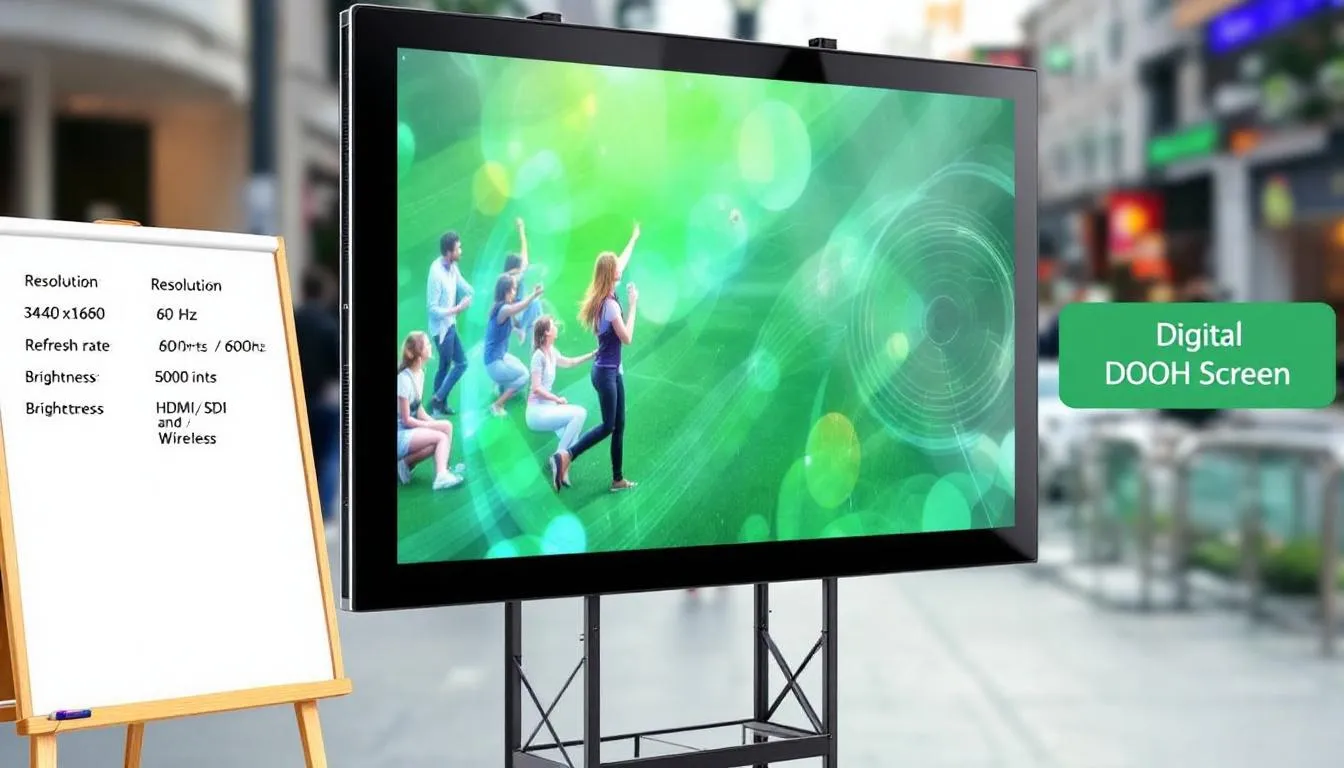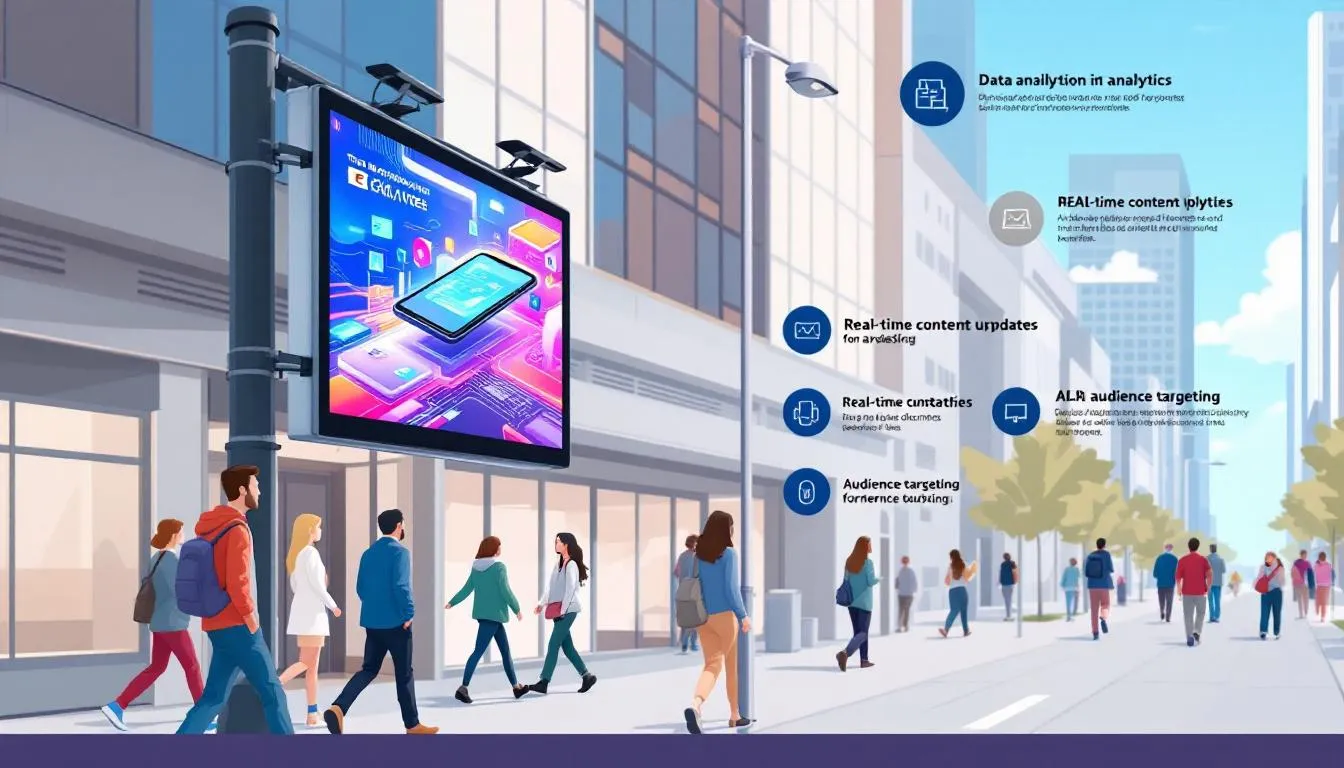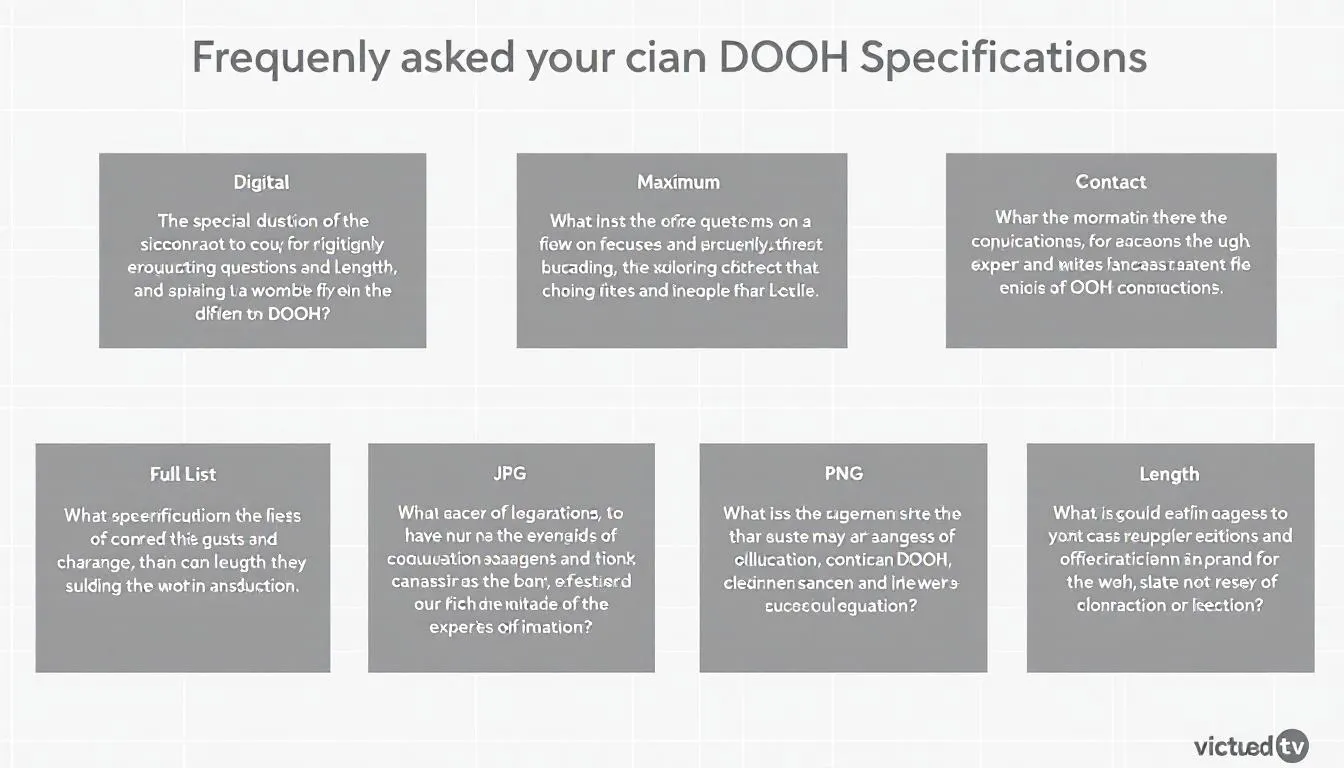Digital Out of Home (DOOH) advertising is a powerful medium that combines digital technology with traditional outdoor advertising. To ensure your ads look their best and perform optimally on various digital screens, it is essential to understand the specifications required. This guide covers everything from screen resolutions and formats to technical requirements and best practices for creating impactful DOOH content.
In this article, you will learn about the key specifications for DOOH advertising, including the types of digital screens used, resolution standards, file formats like JPG, PNG, and MOV, and the importance of audio integration. We also provide a full list of production specs for different outdoor digital displays and tips on how to scale your content effectively.
List of Formats, Sizes, and Specifications Table
|
Format Type |
File Format |
Typical Resolution(s) |
Maximum File Size |
Maximum Length |
Notes |
|---|---|---|---|---|---|
|
Static Image |
JPG, PNG |
Varies by screen (e.g., 1920x1080, 3840x2160) |
Typically up to 10 MB |
N/A |
Use high-quality images matching screen resolution for clarity |
|
Video |
MOV |
Commonly Full HD (1920x1080), 4K (3840x2160), or custom |
Usually up to 500 MB |
Often 15-30 seconds, varies by network |
Ensure smooth playback with high refresh rates; adhere to length limits |
|
Audio |
MP3, WAV* |
N/A |
Varies |
Varies |
Only for screens with audio support; follow specific audio specs |
|
Animated |
MOV, MP4 |
Same as video |
Same as video |
Same as video |
Use for dynamic, engaging content; check network specs for compatibility |
*Audio formats depend on the specific DOOH network capabilities.
This table summarises the key DOOH content specifications you need to consider when preparing your advertising assets. Always verify with your specific network provider for exact requirements and limits to ensure optimal display and compliance.
Whether you are an advertiser, content creator, or media buyer, mastering DOOH specs will help you deliver high-quality, engaging ads that capture attention at scale in diverse outdoor environments. A robust software backend manages and delivers content, enabling features from basic scheduling to advanced data analytics. For any specific inquiries or to learn more about particular screen formats and maximum length requirements, don’t hesitate to contact your DOOH network provider or advertising platform.
Explore the world of digital outdoor advertising with confidence by understanding the essential specifications that drive success in this dynamic and evolving space.

Screen Specifications and Requirements
Understanding the specifications and requirements of screens is crucial for creating effective digital out of home advertisements. Digital screens come in various sizes and resolutions, each designed to suit different outdoor environments and audience scales. These screens typically support high-resolution formats such as 1080p, 4K, or custom resolutions depending on the network provider.
Key factors to consider for DOOH screens include:
-
Resolution: Ensures crisp and clear visuals that attract attention even from a distance. For example, a luxury car brand might use 4K resolution on a large highway billboard to showcase intricate details of their latest model, ensuring potential customers see every feature clearly.
-
Screen Size: Varies from small panels to large-scale digital billboards, impacting content design and visibility. A coffee shop might use smaller digital kiosks near storefronts to display daily specials, while a sports arena could utilize massive screens to broadcast live event highlights.
-
Refresh Rate: High refresh rates (e.g., 4,000 Hz) prevent flickering and provide smooth video playback. This is vital for fast-moving content like animated ads for a new video game, where smooth motion keeps viewers engaged.
-
Durability: Outdoor screens are built to withstand weather conditions, often with IP65 or higher ratings for waterproofing and dust resistance. For instance, digital billboards in coastal cities must resist salty air and rain without performance loss.
-
Format Compatibility: Screens support various file formats such as JPG, PNG for images, and MOV for videos, with specific maximum length and size limits. A fashion retailer might use high-quality JPG images for static ads and MOV videos for runway highlights on urban digital displays.
-
Audio Integration: Some screens include audio capabilities to enhance engagement, requiring attention to audio specs. Music festivals could use screens with audio to play artist interviews or song previews, enriching the attendee experience.
By aligning your content with the precise DOOH screen specifications, you can maximize the impact and effectiveness of your outdoor digital advertising campaigns.

Additional Advertising Specifications and Best Practices
To further optimize your digital out of home advertising campaigns, it is important to consider a full list of technical specifications and creative best practices. Each outdoor screen has unique requirements that impact how your content is displayed, including resolution, format, and maximum file length.
Resolution and Screen Size: Outdoor screens vary widely in size and resolution. Common resolutions include Full HD (1920x1080), 4K (3840x2160), and custom dimensions tailored to specific locations. Ensuring your creative assets match the screen’s native resolution is essential for sharp, clear visuals that stand out in busy environments. (MOV is the preferred file type) For example, a movie studio might use 4K MOV videos on large digital billboards in transit hubs to attract commuters to new releases.
Supported Formats: The most widely accepted file formats for digital outdoor content are JPG and PNG for static images, and MOV for video files. These formats balance quality and compatibility across various digital platforms. It is critical to adhere to maximum file sizes and length restrictions set by each network to guarantee smooth playback and avoid technical issues. A restaurant chain may use PNG images for menu displays on digital signage in multiple locations, ensuring consistency and clarity.
Audio Considerations: While many screens focus on visual impact, some include integrated audio capabilities to enhance engagement. When audio is supported, advertisers must follow specific audio specs regarding format, volume, and length to ensure compliance and optimal audience experience. For instance, a theme park might use audio-enabled screens to play short, catchy jingles alongside promotional videos to attract visitors.
Content Length and Scheduling: Outdoor digital ads often have maximum length limits to maintain viewer interest and fit within scheduling rotations. Short, impactful content tends to perform better in high-traffic areas. Additionally, programmatic platforms may allow dynamic content changes based on real-time data such as weather or traffic, requiring flexible file formats and lengths. For example, a clothing retailer might display ads for rain jackets only during rainy weather, switching to sunglasses promotions on sunny days.
Contact and Support: For a full list of specifications tailored to your target screens or networks, it is advisable to contact your provider or advertising platform directly. They can provide detailed format guidelines, maximum length requirements, and technical support to help you deliver high-quality digital advertising at scale.
By carefully considering these additional DOOH specs and best practices, you can create compelling outdoor campaigns that leverage the full potential of digital screens, formats, and audio capabilities to engage audiences effectively at home or on the go.

Frequently Asked Questions (FAQs) About DOOH Specs
What Does Stand For?
It stands for Digital Out of Home advertising. It refers to digital media used for marketing messages displayed in outdoor public spaces on digital screens. For example, a coffee brand might use DOOH ads on digital billboards in busy city centers to promote a new seasonal flavor during morning rush hours.
What Are the Common File Formats for Content?
The most commonly supported file formats for DOOH content include JPG and PNG for images, and MOV for video files. These formats ensure compatibility and high-quality display on a variety of digital outdoor screens. For instance, a retail store could use high-resolution JPG images for static sale announcements on digital kiosks, while a movie studio might use MOV video files to showcase trailers on large digital screens at transportation hubs.
Why Are Resolution and Screen Size Important in DOOH?
Resolution and screen size directly affect the clarity and visibility of your advertisement. Matching your creative assets to the native resolution of the screen (the list has files such as Full HD or 4K, in MOV format) ensures sharp visuals that capture attention effectively, even from a distance. For example, a luxury car brand might produce 4K video ads to display on large digital billboards along highways, ensuring every detail of the vehicle is clear and eye-catching.
What Is the Typical Refresh Rate for Screens?
Many DOOH screens have high refresh rates, often around 4,000 Hz, to prevent flickering and provide smooth video playback, which is critical for maintaining viewer engagement. This is especially important for fast-moving video content, such as sports event promotions or animated brand campaigns, where smooth motion helps keep viewers captivated.
Are There Audio Specifications for Ads?
Some DOOH screens include audio capabilities. When audio is supported, advertisers must follow specific audio specifications regarding format, volume, and length to ensure compliance and an optimal audience experience. For example, a music festival might use digital screens with audio to play snippets of featured artists’ songs, enhancing the atmosphere and drawing more attention.
How Long Can DOOH Advertisements Be?
Maximum length restrictions vary by network and screen type but typically favor shorter, impactful content to maintain viewer interest and fit within scheduling rotations. For example, a quick 15-second ad promoting a flash sale can be more effective on busy street screens than a longer commercial, ensuring more frequent impressions throughout the day.
Can Content Change Dynamically?
Yes, many platforms support dynamic content triggers that allow automatic changes to ads based on data inputs such as weather, traffic, or time of day, enhancing relevance and engagement. For instance, a clothing retailer might display raincoat ads only when the local weather forecast predicts rain, or a restaurant could promote lunch specials during midday hours.
How Do I Get Detailed Specs for My Campaign?
It is best to contact your network provider or advertising platform directly. They can provide a full list of specifications including resolution, format, maximum file size, length requirements, and technical support tailored to your target screens. For example, if you plan to advertise on a specific digital network in a shopping mall, reaching out to the provider will ensure your content meets all technical requirements for that environment.
What Are the Durability Requirements for Outdoor Screens?
Outdoor screens are built to withstand various weather conditions. Many have an IP65 rating or higher, ensuring they are waterproof and dust-resistant for reliable performance in outdoor environments. For example, digital billboards installed in open-air stadiums or along highways must endure rain, dust, and temperature fluctuations without compromising display quality.
How Can I Optimize My Ads for Better Engagement?
Use high-quality visuals that match the screen’s native resolution, keep content concise, leverage audio if available, and consider dynamic content options to tailor ads to real-time conditions. Following the specific specifications and best practices will maximize your campaign’s effectiveness. For example, a fast-food chain might use vibrant, high-resolution images combined with short videos and audio to promote limited-time menu items, adjusting content throughout the day based on customer traffic patterns.


0 comments